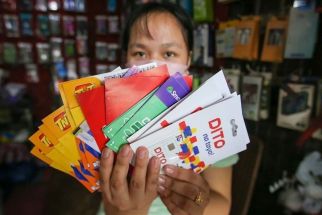Communication devices of last resort: Sat phones at the front lines
MANILA, Philippines - It is not often that CNN’s Anderson Cooper lends his phone to a man in the street, but lend it he did to a despondent male survivor that he interviewed in the debris-laden streets of Tacloban City during his coverage of the aftermath of Typhoon Yolanda.
The man, who had lost his wife and two children as well as all his belongings, broke down while using Anderson’s satellite phone. “They are gone, they are all gone,†he cried, talking to his mother in Manila.
That emotionally charged video, shown repeatedly here and all over the world, put the spotlight on one of the handiest devices to have during a massive calamity — the satellite mobile phone.
When Yolanda made landfall on Nov. 8 in Eastern Visayas, she devastated entire towns and cities, savaged key utility infrastructure like water systems and power, and, telephone lines and cellphone towers. That cut off Tacloban, Borongan and other towns in Leyte and Eastern Samar from the rest of the world and muffled the voices of thousands of people desperately crying for help.
That silence was broken the following day, in the afternoon of Nov. 9, when Smart Communications Inc. set up the first “Libreng Tawag†station in the city using satellite telephony at the Tacloban police headquarters.
“Among the first to call were the Benedictine sisters who ran the only remaining private hospital operating in the city. They were asking their fellow sisters in Manila to send badly needed medicine because the hospital was full of patients and they were running out of supplies,†said Michelle Bayhonan, who helped run the Libreng Tawag station.
Satellite phones have emerged as communication devices of last resort in extreme circumstances created by mega-disasters like Yolanda with its peak winds of over 300 kilometers per hour and its destructive storm surge.
Unlike their cellular counterparts which rely on land-based infrastructure that can be damaged by super typhoons, satellite phones rely on a network of satellites up in the sky that are either fixed above the equator or in low earth orbit anywhere from 500 to 1,000 miles above the earth.
The only Philippine operator offering satellite phone services, Smart pre-positioned a number of its own sat phones in the provinces in the path of the storm to help its engineers conduct network recovery operations.
After Yolanda had laid waste to large areas in Eastern Visayas, Smart dispatched 120 satellite phones to the towns and cities that had been most affected and been isolated. Most of these phones were running on the international satellite service run by Dubai-based Thuraya Telecommunications. Others were provided by Smart’s partners such as Telecoms Sans Frontieres.
About half of these phones were used to set up free call stations for the public in places like Tacloban, Ormoc, and Palo in Leyte, and in Borongan, Guiuan, Dolores, Sulat, and Hernani in Eastern Samar. These were also used by Smart engineers to maintain communications while restoring network services in the affected areas.
In partnership with Thuraya, Smart distributed the other half of these satellite phones to various government agencies and non-government relief organizations for use free of charge.
This included the National Disaster Risk Reduction and Management Council (NDRRMC) and the Office of Civil Defense, the Armed Forces of the Philippines’ general headquarters and the Philippine Air Force which was ferrying people, equipment and supplies to Tacloban and other badly affected areas.
Satellite phones were also provided the Office of the President and the Presidential Communications Operations Office, and the departments of Energy, Social Welfare and Development, Interior and Local Government, Trade and Industry, and Labor and Employment. The Philippine Red Cross and OxFam International were also given satellite phones to use.
Cebu Gov. Hilario Davide III used the Smart satellite phone to coordinate relief efforts when he visited Daanbantayan and Bantayan, which had been leveled when Yolanda made landfalls in both places. He also gave a phone patch interview over a Cebu radio station.
Iloilo Gov. Arthur Defensor deployed Smart satellite phones to three towns — Batad, Balasan and Estancia — where communications lines had been cut.
Even private citizens gave a helping hand. A lawyer from Cebu City, Kate Go, volunteered to bring a satellite phone to Guiuan town in Eastern Samar to help coordinate relief efforts. Together with Cebu-based journalist Michelle So, she flew to Guiuan on a private plane and set up the satellite phone, which was also used by the military forces there.
She later turned over the phone to local businesswoman Susan Tan, who was featured in the newspapers because her store was emptied by hungry storm survivors. The satellite phone is now being used for free calls under her care.
In these various ways, satellite phones were deployed in the typhoon-struck areas and have provided vital communications links to support government and NGO relief efforts despite the severe conditions.
“Super Typhoon Yolanda has raised the bar for disaster preparedness. After this, you cannot be really prepared for emergencies unless your disaster preparedness kit has a Smart satellite phone,†said Mon Isberto, Smart head for public affairs.
- Latest


























